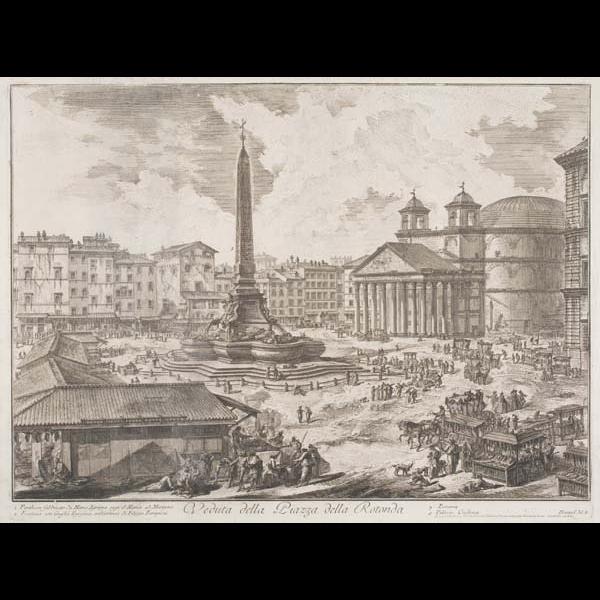Piranesi, Pantheon

Piranesi's 1751 Veduta della Piazza della Rotonda. The etch shows the piazza and the Pantheon as seen in Piranesi's contemporary Rome, complete with the fountain and obelisk at the center of the square.
This print is Giovanni Battista Piranesi’s Veduta della Piazza della Rotunda. This etching shows the Pantheon and Obelisk in the Piazza della Rotunda located in Rome, Italy. Piranesi had begun a series around 1747, called Vedute di Roma (Views of Rome), in which he etched several plates showing historical monuments and notable landmarks in the city. This etching of the Pantheon, completed in 1751, interestingly does not place central emphasis on the Pantheon itself, but rather, more on its surroundings. In this particular work, Piranesi provides more of a historical and environmental context for the monuments depicted.
During his lifetime, Piranesi created several different etchings of the Pantheon that focused more on the monument itself. Yet the value of this etching lies in its portrayal of the Pantheon as Piranesi saw it. Here the Pantheon and the Obelisk are immersed within the context of everyday Rome, surrounded by the hustle and bustle of the lively piazza. Fish markets, horse-drawn carriages, and shoppers divert the attention from the grandiose monuments and reveal its casual interaction with Piranesi’s contemporary society.
The composition of the work opens up the piazza, providing a wide landscape framed by the buildings that surround the towering obelisk and fountain. Instead of detailing the Pantheon’s impressive and iconic dome, Piranesi only begins to indicate it. Instead, he shows evidence of the changes in the Pantheon’s use and significance over time. In the 17th century, Pope Urban VIII added bell towers as a Christian addition to the facade, compromising its original, Classical Greek-inspired portico. Thus, the etching shows a different monument than what we see today — the towers, often called the “ass’s ears”, have since been removed in the 1880s.
ML